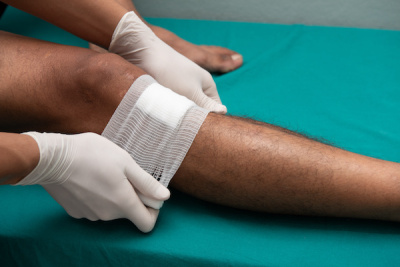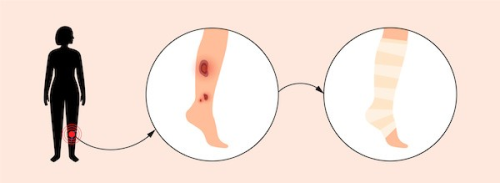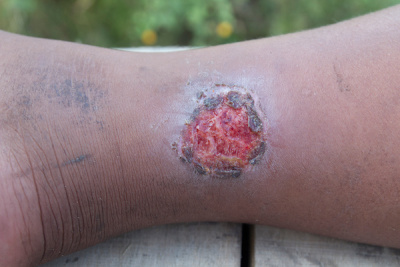Does hemp ointment also help with leg ulcers?
Author: Lucie Garabasova
A leg ulcer refers to a chronic, non-healing open wound. Generally, we distinguish between venous and arterial ulcers. In treating leg ulcers, an active approach by the patient is, of course, crucial. In this article, you'll learn everything about how they develop, how they are classified, and how they are treated.
You'll also discover how they can be prevented and the potential of our CBD products and hemp ointment in their treatment.
How does a leg ulcer develop, and how do we classify it?
A leg ulcer is a chronic skin defect that often arises from a small injury (such as a scratch or abrasion) that takes a long time to heal. Initially, a red spot appears on the skin, which begins to dry out. Over time, it forms a scab that cracks, leading to a wound that penetrates into the underlying tissue. There is a significant risk of infection in the wound, which can cause it to emit an unpleasant odor. The name of this condition is derived from the area where it typically develops, the shin (shin = the lower leg area between the knee and the ankle).
The most common causes of leg ulcers include:
- Venous disease
- Arterial disease
- Diabetes
- Other causes (e.g., injuries, excessive heat or cold)
Often, these ulcers result from a combination of multiple factors. They can also develop as a consequence of various conditions, such as tumors, autoimmune disorders, hematological, lymphatic, and other diseases.
Leg ulcers are classified as follows:
Venous leg ulcer
This type of ulcer develops as a result of chronic venous disease. Over time, a patient may develop venous valve incompetence (which causes some blood to flow back down into the veins instead of being pushed back toward the heart). This leads to increased pressure in the venous system, causing vein enlargement, swelling, and skin changes—in advanced stages, resulting in leg ulcers.
Leg ulcers often develop from minor skin defects due to injuries that are complicated by bacterial flora and are difficult to heal. However, an ulcer can also develop without any prior injury.
The foundation of treatment is to eliminate or at least mitigate the underlying causes of the condition. This means improving circulation in the affected limbs.
Arterial leg ulcers
This type of ulcer develops relatively suddenly and progresses rapidly. It occurs as a result of peripheral arterial disease in the lower limbs and insufficient blood supply to the peripheral areas. It is most commonly located on the insteps, the backs of the toes, the outer edge of the foot, or the outer side of the calf or ankle. Arterial ulcers are typically deep and very painful, often with necrotic tissue present at the base.
In both cases, it is advisable to consult a doctor who can identify the type of ulcer and choose the appropriate treatment.
Treatment of leg ulcer
Treating leg ulcers is a long-term process, often taking 3 to 4 months for healing.
You should definitely consult a doctor for the treatment of leg ulcers.
Cleaning and dressing the ulcer
The first step in treating leg ulcers is to remove any debris or dead tissue from the ulcer and apply an appropriate dressing (which is usually changed about once a week). This creates the best conditions for treatment and healing.
Compression
To improve venous circulation in the legs and treat swelling, a nurse will apply a firm compression bandage to the affected leg. These bandages are designed to compress the legs and encourage blood flow upward toward the heart.
Applying a compression bandage is a skilled procedure and should only be performed by trained healthcare personnel. The bandage is changed once a week when the dressing is also changed.
Initial bandage application
The first application of a bandage on a leg ulcer can sometimes cause pain, which typically eases as the ulcer begins to heal.
Treatment of associated symptoms of leg ulcers
Swelling in the legs and ankles
Venous leg ulcers are often accompanied by swelling in the legs and ankles, which is caused by fluid retention. This can be managed with compression bandages. Keeping the leg elevated as much as possible also helps reduce swelling. Cooling gels can be applied to further alleviate the swelling.
Additionally, incorporating regular exercise, such as daily walks, is recommended as it can help reduce leg swelling.
Itchy skin
Some people with venous leg ulcers experience rashes with scaly and itchy skin. This is often caused by varicose eczema, which can be treated with appropriate eczema ointment.
In rare cases, you may need to be referred to a dermatologist (skin specialist) for treatment.
Itchy skin can also sometimes be due to an allergic reaction to the bandages or creams applied by the nurse. In such cases, allergy testing may be necessary.
It's important to avoid scratching your legs if you feel itchy, as this can damage the skin and lead to further ulcers.
Does Hemp Ointment help with leg ulcers?
Yes, hemp ointment can be very effective during the treatment of leg ulcers—however, it is recommended to apply it around the wound, not directly into the open ulcer. Hemp ointment containing lanolin helps regenerate the surrounding tissue, which contributes to better ulcer healing.
Additionally, hemp ointment can also be effective for treating associated symptoms of leg ulcers, such as the eczema mentioned earlier.
We always recommend choosing a hemp ointment that does not contain chili, as this could irritate the area around the wound. A formulation with calendula would be ideal.
How does CBD work on leg ulcers?
CBD (What is CBD?) is crucial to use internally during the treatment of leg ulcers. CBD itself has strong anti-inflammatory properties and helps relieve pain and reduce itching. In addition to CBD, we would also recommend incorporating CBG, which helps regenerate skin cells.
Leg ulcer treatment – For leg ulcers, we recommend using a combination of products internally: CBD + CBG hemp oil.
Study: Faster healing of leg ulcers with CBD
A new study published in May 2021 in the journal Experimental Dermatology shows that a combination of cannabidiol, terpenes, and flavonoids leads to rapid wound closure in previously non-healing venous leg ulcers in elderly and highly complicated patients.
The study included 14 patients with 16 chronic and non-healing leg ulcers. The average age of the patients was 75.8 years, all of whom had chronic wounds. All patients had venous leg ulcers for more than six months that had not closed despite at least four weeks of compression therapy.
The modern CBD-based treatments used in this study consisted of blends of cannabinoids, terpenes, and flavonoids, which were applied topically to the wound bed and surrounding tissue. Treatment was performed every other day and continued until the wound was completely closed.
The study evaluation was scheduled for 34 days after the first application.
Complete wound closure, defined as full epithelialization, was achieved in 11 patients (79%) and 13 wounds (81%) within a median of 34 days. No significant adverse effects were reported in any of the patients. The remaining 3 patients could not complete the study as they withdrew due to unrelated issues.
These positive outcomes are attributed to the potentiation and synergy between cannabinoids, terpenes, and flavonoids, the researchers conclude.
The rapid closure of previously non-healing venous leg ulcers in elderly and highly complicated patients suggests that topical cannabis-based treatments may become effective adjuncts to compression therapy. It also suggests they may have a broader role in skin and wound care.
Is there prevention for leg ulcers?
Some conditions that can cause leg ulcers can be prevented through regular physical activity (if you have a sedentary job, it’s good to stand up several times a day and lift yourself onto your toes), a balanced diet, and if you feel that your legs are tired, elevating them above the level of your body for a while (this helps proper lymphatic circulation).




